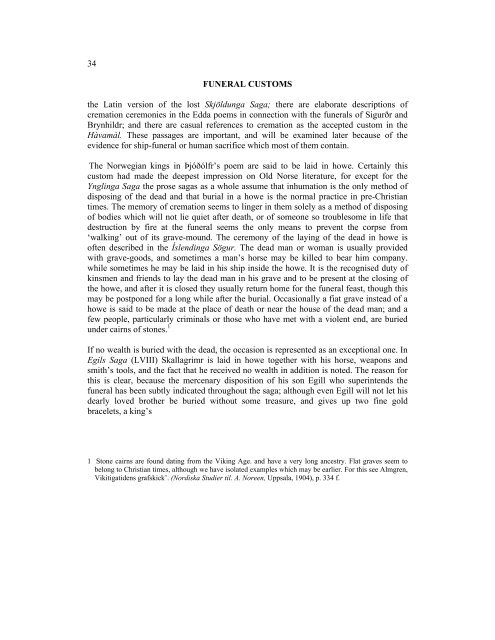Road To Hel - Rune Web Vitki
Road To Hel - Rune Web Vitki
Road To Hel - Rune Web Vitki
You also want an ePaper? Increase the reach of your titles
YUMPU automatically turns print PDFs into web optimized ePapers that Google loves.
34<br />
FUNERAL CUSTOMS<br />
the Latin version of the lost Skjöldunga Saga; there are elaborate descriptions of<br />
cremation ceremonies in the Edda poems in connection with the funerals of Sigurðr and<br />
Brynhildr; and there are casual references to cremation as the accepted custom in the<br />
Hàvamàl. These passages are important, and will be examined later because of the<br />
evidence for ship-funeral or human sacrifice which most of them contain.<br />
The Norwegian kings in Þjóðólfr’s poem are said to be laid in howe. Certainly this<br />
custom had made the deepest impression on Old Norse literature, for except for the<br />
Ynglinga Saga the prose sagas as a whole assume that inhumation is the only method of<br />
disposing of the dead and that burial in a howe is the normal practice in pre-Christian<br />
times. The memory of cremation seems to linger in them solely as a method of disposing<br />
of bodies which will not lie quiet after death, or of someone so troublesome in life that<br />
destruction by fire at the funeral seems the only means to prevent the corpse from<br />
‘walking’ out of its grave-mound. The ceremony of the laying of the dead in howe is<br />
often described in the Íslendinga Sögur. The dead man or woman is usually provided<br />
with grave-goods, and sometimes a man’s horse may be killed to bear him company.<br />
while sometimes he may be laid in his ship inside the howe. It is the recognised duty of<br />
kinsmen and friends to lay the dead man in his grave and to be present at the closing of<br />
the howe, and after it is closed they usually return home for the funeral feast, though this<br />
may be postponed for a long while after the burial. Occasionally a fiat grave instead of a<br />
howe is said to be made at the place of death or near the house of the dead man; and a<br />
few people, particularly criminals or those who have met with a violent end, are buried<br />
under cairns of stones. 1<br />
If no wealth is buried with the dead, the occasion is represented as an exceptional one. In<br />
Egils Saga (LVIII) Skallagrimr is laid in howe together with his horse, weapons and<br />
smith’s tools, and the fact that he received no wealth in addition is noted. The reason for<br />
this is clear, because the mercenary disposition of his son Egill who superintends the<br />
funeral has been subtly indicated throughout the saga; although even Egill will not let his<br />
dearly loved brother be buried without some treasure, and gives up two fine gold<br />
bracelets, a king’s<br />
1 Stone cairns are found dating from the Viking Age. and have a very long ancestry. Flat graves seem to<br />
belong to Christian times, although we have isolated examples which may be earlier. For this see Almgren,<br />
Vikitigatidens grafskick’. (Nordiska Studier til. A. Noreen, Uppsala, 1904), p. 334 f.
















